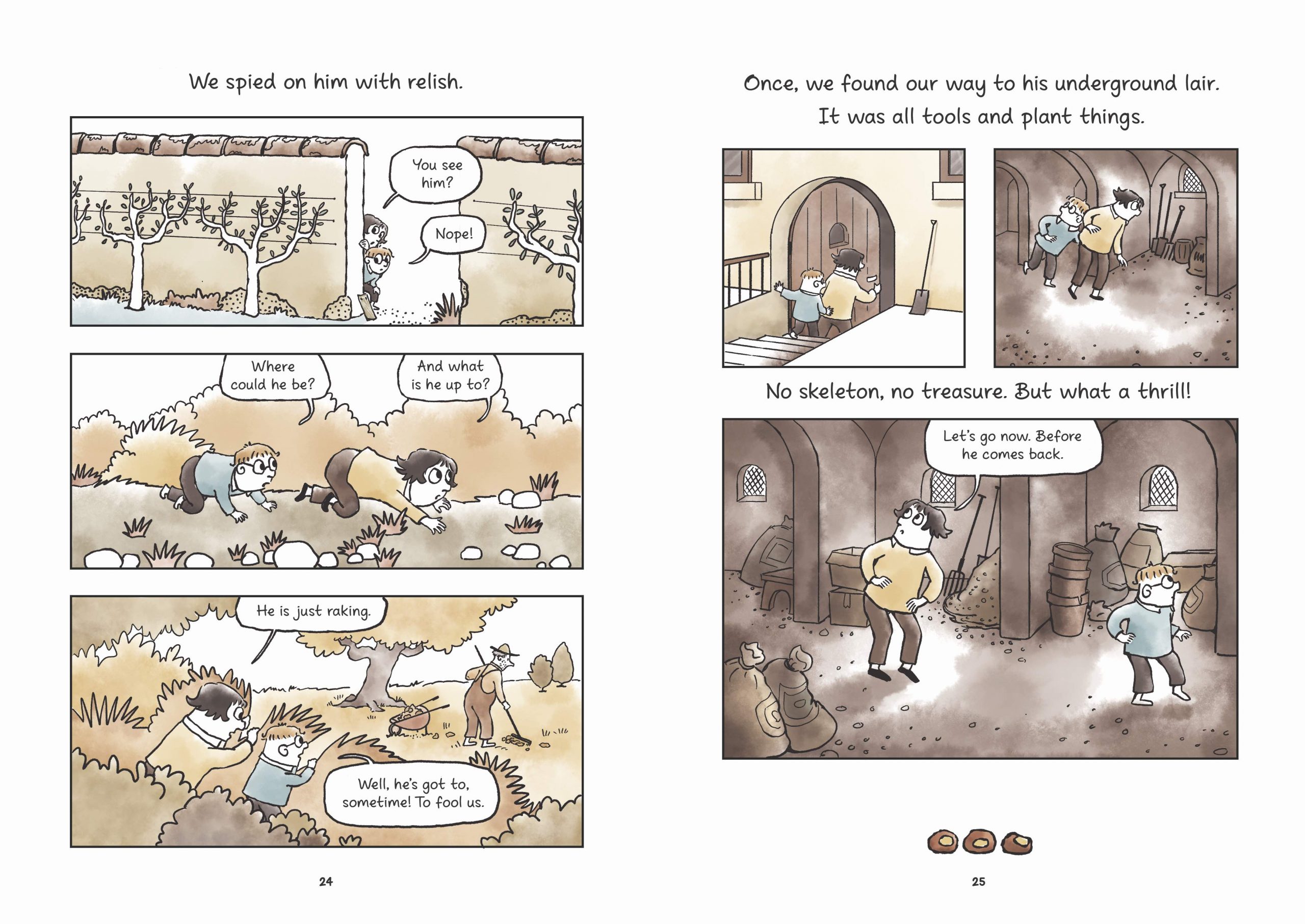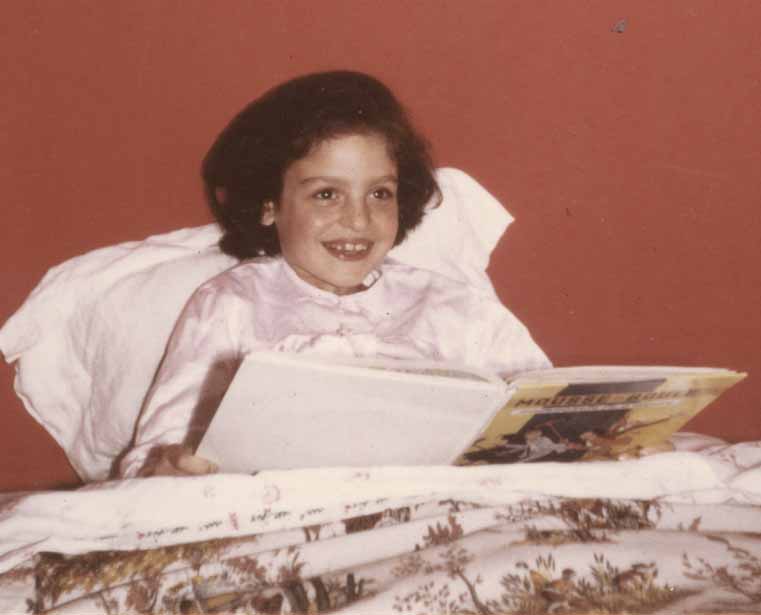–
“My picture book background did help me
a lot with pacing
and the importance of visual variety,
and I will also credit years of reading
graphic novels and comics!”
— Sylvie Kantorovitz
=
Sylvie Kantorovitz is a true artist from the top of her head down to the soles of her shoes. She’s just one of those rare people where creating art in some form seems as natural as breathing. Sylvie’s latest book, a memoir in graphic novel form, is a triumph in every way. It’s a book that could have been titled, “Portrait of the Artist as a Young Child and Woman.” You can’t help but be charmed by Sylvie’s story — her uncanny recollections of childhood — the warmth of her illustrations — and the path of her self-discovery. After I finished admiring the book, I invited Sylvie over to the swanky corporate offices here at the 14th floor of James Preller Dot Com. Let’s meet her!
–
I can’t wait to talk about this terrific book, so let’s get started. As I understand it, this book was something of a happy accident. You didn’t set out to write a memoir?
I knew I wanted to write a graphic novel. I knew I wanted to base it on my memories of growing up in France. But I was worried about not remembering enough. At first I called the main character Lisette, and labeled my work “a fictional memoir”. Then I found out I remembered plenty! And one day my agent asked this very simple question: Is it fiction or is it a memoir? And the answer jumped at me: of course it is a memoir!
There’s a minor moment early in the book, four illustrations across two pages. You are circling a favorite tree, stepping on the roots with your brother Alibert, careful not to fall off. And to me, that was absolute perfection. You captured something that felt so right, childlike and authentic. I remember that exact feeling, careful not to fall into the shark-infested waters.
Thank you! I really love how universal these early childhood games seem to be. Pretending the floor is lava. Or the bed is in the middle of an ocean teaming with pirates and sharks. How thrilling imaginary danger is!
I want to get at this by avoiding a couple of standard pat answers. We often hear: 1) I’m still a 7-year-old in my heart; or 2) I still have a  direct line to my childhood. And while those two things might be true for you, I want to ask: Why do you think those moments still resonate for us, still linger so powerfully in our memories?
direct line to my childhood. And while those two things might be true for you, I want to ask: Why do you think those moments still resonate for us, still linger so powerfully in our memories?
Haha! I am definitely not a 7-year-old at heart any more, nor do I have a direct line to my childhood! For me, as I get older, I want to define who I am, what is important to me. I want to embrace that fully and also decide how I want to use the time I have left. It’s hard work, and my memories are one of the tools that help me in figuring all that out.
It’s interesting how this creative act opened up a flood of memories for you — forgotten memories, if there’s such a thing.
I was happy to find out that memories have a way of triggering each other. In fact, more are still coming! What became a challenge was what to keep. I chose anecdotes that I thought showed an emotional moment in the story, or allowed me to expand on who a character was. Like showing what happened when my sister fell through a roof, or when my father took me to Paris, or when I messed up on an important school test.
There’s a lot of playing in your book, which I found so relatable. An experience that is at the core of us all, I’d think. Did that come back to you easily?
Actually yes. The school where my family lived was like a giant playground! We played in the classrooms, spied on the gardener, once had a sleepover in the infirmary. I also wanted to show how similar playtime is for children in another country, including games like hopscotch or marbles.
I could personally identify with the magical visits to your father’s office, where he had a ready supply of paper clips, markers, pens, tape, paper. Heaven for a young artist. As a boy, I used to go to my father’s insurance office. He had something that trumped all that: tracing paper!
I can’t help wondering: tracing paper in an insurance office? But how about the thrill of using a manual typewriter? That also was such fun!
–
—
Yes, it sure was, though I was dazzled with the first electric typewriter. Wowza! I especially appreciate the variety of images and artwork, the pacing. It’s as if each chapter is its own complete, self-contained picture book, where the artwork flows in different shapes and sizes. Each spread contains a new surprise. You make it look easy.
My picture book background did help me a lot with pacing and the importance of visual variety, and I will also credit years of reading graphic novels and comics! Growing up in France when I did, I was immersed in a great comics culture which I am so glad has arrived here too. The variety available now for kids is amazing!
Your mother was tough. She said some harsh things, too. How was it looking back on that now, so many years later?
Haha! I didn’t wait to write a memoir in order to examine the effect of my parent’s influence on my adult mind. So pondering over my mother’s style was nothing new to me. In the book, I tried to show a balanced view of my mother, such as her also being caring and affectionate. And how confusing those mixed messages are for a child to navigate.
Are your parents still alive? And if so, how did they react to the book?
My father died many years ago but I think he would have been pleased. He loved all forms of expression, from the classics to popular genres to comics. My mother died during the pandemic, a few months before publication. But I think she would have been oddly proud to figure so prominently in a book by her “American” daughter.
–
There’s a lot of cleaning in this book! Are you as neat today?
Haha! I really am! I love cleanliness and order. It really started with getting that skeleton key to my own little attic room. I still sigh with pleasure when I think of the orderly little domain I created as a girl.
Could we see a photo of your workspace (but no cheating — I don’t want you cleaning beforehand!)?
My two tables:
–
–
That’s so cool, thanks for giving us that glimpse. Sylvie follows your life from childhood to college. A journey of self-discovery. What age reader is this book intended for?
It is listed as a book for children 8 to 12. But I have had a lot of feedback from adults who have loved it, which is great.
I love that very last image of you sitting on a train, a zoomy blur, catapulting into the future. You are on your way! When did you know that would be the final image?
That scene actually moved from the very beginning — Sylvie thinking back on her youth — to the very end — Sylvie on her way to her future. I think it worked out well, as the theme of the train kept cropping up: waving at trains, taking a train for the first time without parents, loving a song about a train whistling in the night. For me the train is a metaphor for the longing I felt to go places. A longing that eventually brought me to the United States.
I’d be remiss if I didn’t ask about your partner, the lovely and talented Barbara Lehman. How is she?
 Barbara is well, thank you. Her latest book came out very recently: Little Red and the Cat who Loved Cake. The Horn Book called it “Another triumph from a master of wordless picture books.” I agree! It is also very funny.
Barbara is well, thank you. Her latest book came out very recently: Little Red and the Cat who Loved Cake. The Horn Book called it “Another triumph from a master of wordless picture books.” I agree! It is also very funny.
You are also a fine painter. Is your work available for sale?
Thank you. At this time, I do not actively try to sell my artwork. At my art table, I can do whatever I want. However, I am always happy if someone wants to own a piece. People often contact me privately and I have sold much art that way through the years.
Last question: you must have learned a lot by reflecting on your life in this way. Stories give it shape and meaning. Did anything surprise you along the way?
I was delighted to find out my young self was not that different from who I am now. My views on people and life have evolved, of course, but my core values are essentially the same. I also realized how similar I am to my father. And I like that. It is something I hadn’t fully realized before because I didn’t have a reason to reexamine my memories and look at the bigger picture. I am glad I did!
Sylvie, I’m a little abashed by how many questions I asked you. My apologies. I truly loved your book and, of course, I’ve been a fan for many years. Thanks for giving us your life in this format, and your time in this interview.
I enjoyed this conversation, James! And now, back to the drawing board.
–
To learn more about Sylvie Kantorovitz, you can find her on Twitter, Instagram, Facebook, or her website. She’s published many other picture books, including The Very Tiny Baby, Zig and the Magic Umbrella, and more.





























